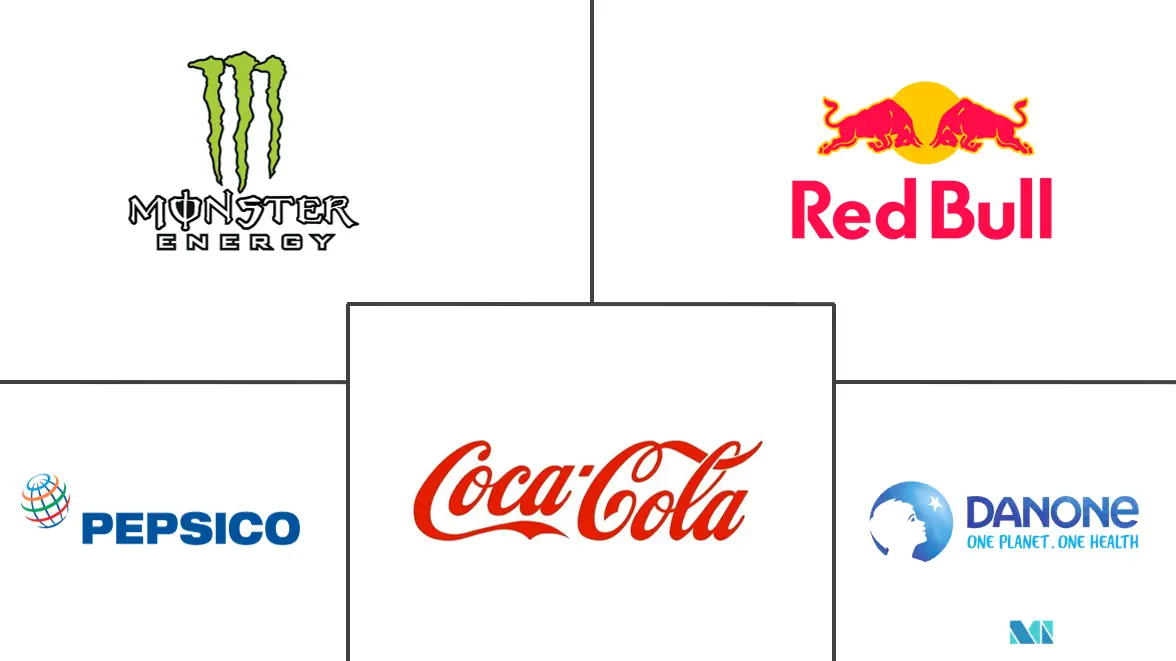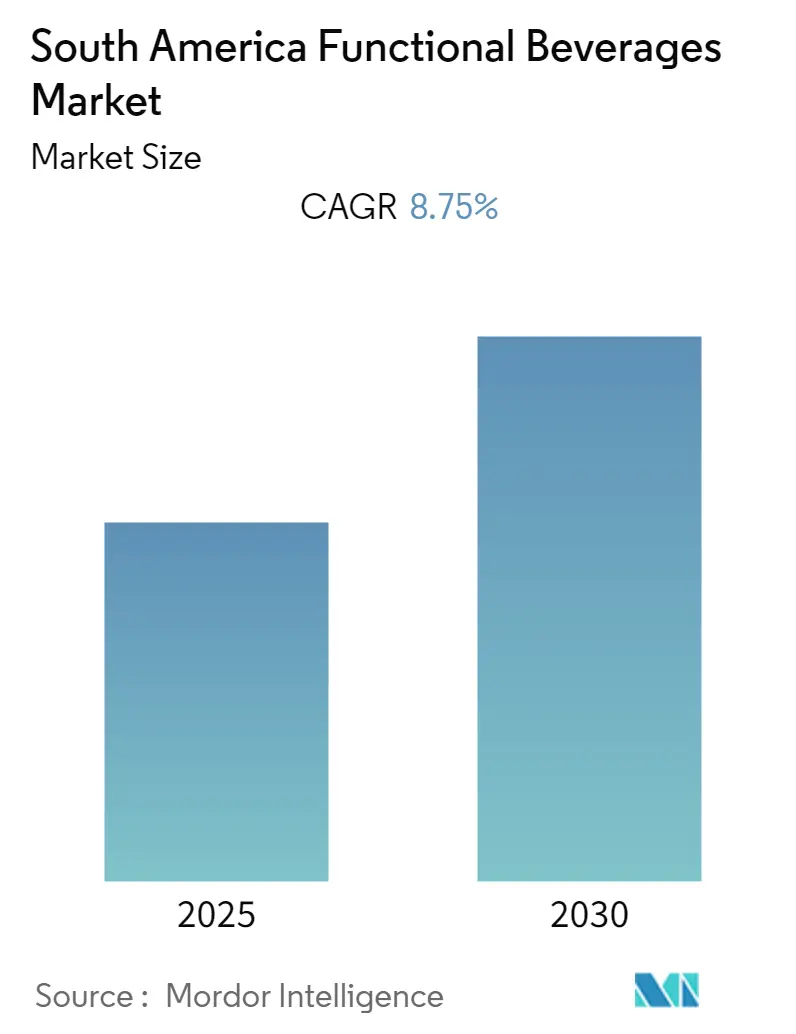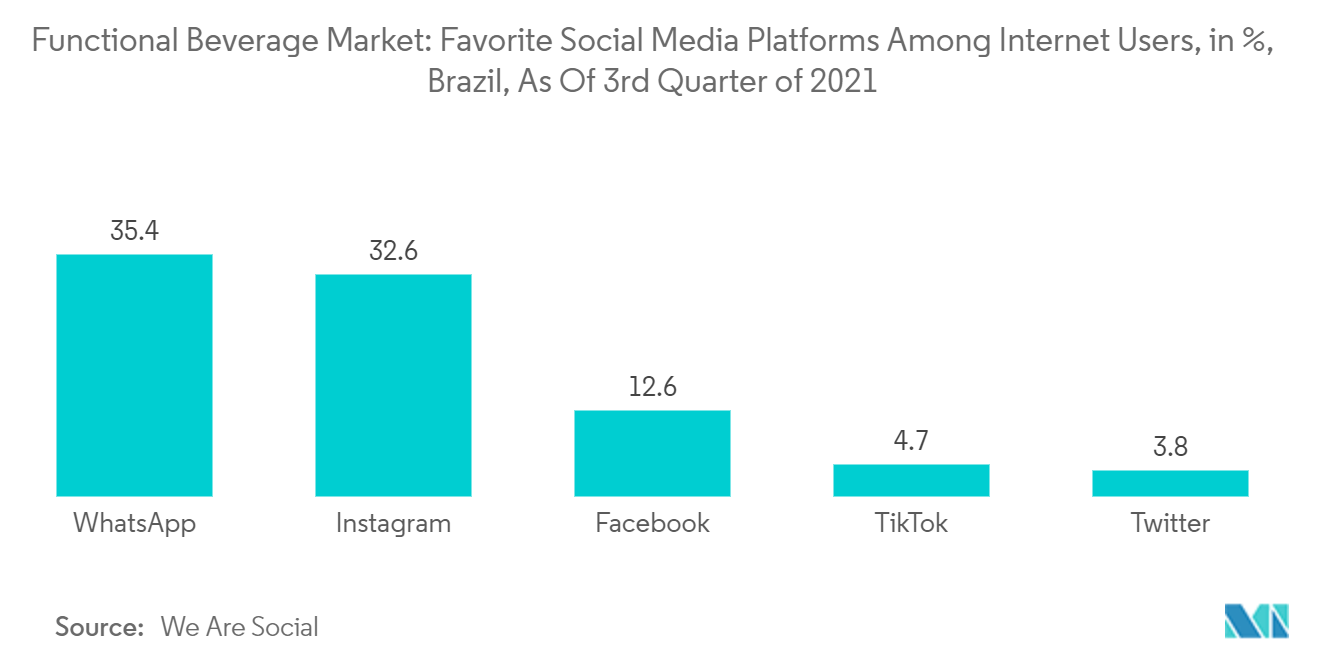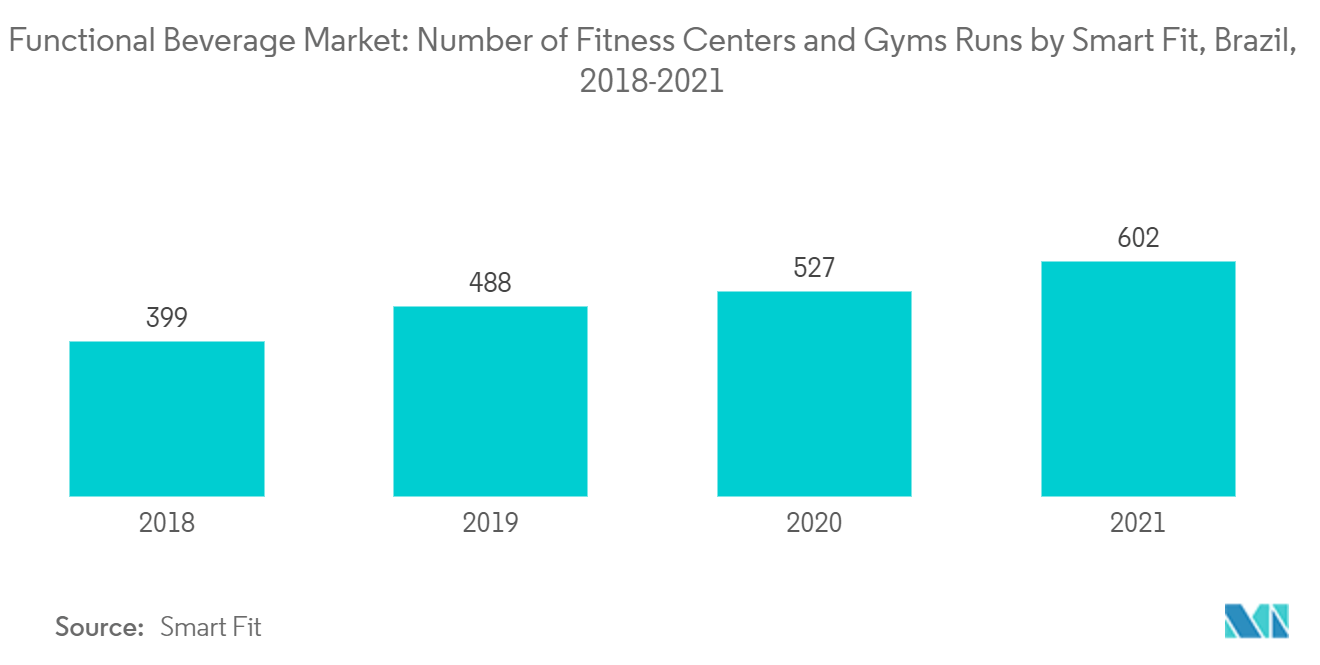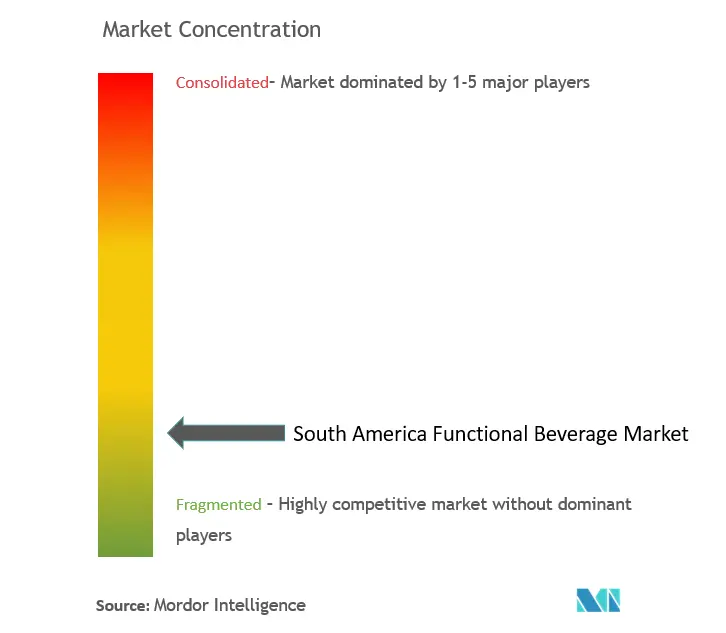Functional Beverage in South America Market Analysis
The South America Functional Beverages Market is expected to register a CAGR of 8.75% during the forecast period.
Health and wellness trends are a big reason why people want drinks that do more than just taste good.As health and disease prevention claims are being made about beverages, consumers are becoming more and more interested in how true those claims are.Changes in consumer needs, such as for immunity and sustainability, as well as a number of market trends, are driving the rise of premium functional beverages and helping the market grow in the region.
Functional drinks that contain protein and claim to give you more energy are becoming more popular, especially among people who like to work out.Immunity is also surging as a key claim in the market. Furthermore, digestive health is likely to be the next functional crowd-pleaser, and brands can leverage this opportunity to create products for which consumers will pay a premium. The increasing number of fitness centers in the region is also contributing to this cause.
As the functional beverage market is highly competitive, manufacturers who want to stand out in the crowd need to stay in tune with changing consumer needs and deliver innovation with the proven scientific benefits of powerful functional ingredients. However, with the increasing health issues associated with the consumption of functional beverages, followed by the prevalence of obesity, the low penetration of functional drinks in other untapped regions might pose hindrances to the overall growth of functional beverages in the region.
Functional Beverage in South America Market Trends
Augmented Expenditure on Advertisement and Promotional Activities
Functional drinks are becoming very popular among millennials because of the aggressive marketing campaigns that big beverage companies are running to attract young customers. Functional drinks like energy drinks, sports drinks, and other fortified drinks are being advertised as drinks that wake up the mind, refresh the body, and improve performance and stamina. This is catching the attention of consumers. A few of the most important things that affect market growth are building brand image and trademarks, as well as advertising costs, endorsements, and sponsorships. A significant number of key players' promotional expenses result from endorsement and sponsorship contracts. For instance, as part of their promotional strategy, key players, like Red Bull, own football teams, with clubs in Brazil featuring the Red Bull trademark in their names, along with getting associated with other teams like the Argentina football team, further promoting their presence in the region. By associating the drink's image with these activities, the company seeks to promote its public image and raise brand power. Further, social media has become a very influential factor in deciding the purchasing behavior of consumers across the world. Hence, the enhanced promotions of functional beverages like sports drinks and energy drinks on different social media channels are further supporting market growth.
Brazil Holds a Major Share in the Market
Brazil's functional beverage market benefits from the country's strong economy and health consciousness. The aging population is fueling the demand for functional beverages to prevent or overcome health conditions. The increasing number of single households and a growing mobile society are changing the food and beverage consumption pattern in favor of the convenience food industry. Thus, there is a rise in the demand for convenient food, including functional beverages. Chocolate-based flavored drinks have seen growth in the market due to their taste and enriched properties, as well as being anticipated to boost the overall market. The demand for energy drinks has increased as urbanization, disposable income, and health consciousness among Brazilian consumers have expanded. Energy drinks are widely popular among youngsters due to their claims to improve performance, endurance, and alertness. Adding to this, the increasing number of fitness centers and gyms in the country, owing to the rising number of fitness enthusiasts, is further propelling the growth of functional beverages like sports drinks and energy drinks in the market. The large consumer base in Brazil consuming functional beverages such as non-alcoholic beverages and energy drinks is contributing to the overall market's growth. The presence of several popular soda companies in the country further contributes to market growth.
Functional Beverage in South America Industry Overview
The South American functional beverage market is a competitive one, with several major players present. In the future, a company's growth in the functional beverage industry will depend on how it sells its products, how it comes up with new products, and how well they are packaged. The major corporations are located in all regions and major countries within those regions. The most active companies in the South American functional beverage market include PepsiCo Inc., Danone SA, The Coca-Cola Company, Monster Beverage Corporation, and Red Bull GmbH. To control the market for functional beverages in the area, several of the big competitors have assessed the quality of the industry and developed innovations that could appeal to a sizable consumer base.
Functional Beverage in South America Market Leaders
-
PepsiCo, Inc.
-
The Coca-Cola Company
-
Red Bull GmbH
-
Monster Beverage Corporation
-
Danone SA
- *Disclaimer: Major Players sorted in no particular order
Functional Beverage in South America Market News
- November 2022: BioZen launched its kefir drinks in Brazil. The company initially launched kombucha in the market and is expanding its presence in the low-sugar and gut health-proclaiming drinks.
- August 2022: Urbe Cafe announced the launch of its cold brew in the Brazilian market. This is in line with the company's strategy to compete with the energy drinks available on the market.
- March 2021: Red Bull launched a new summer limited edition in Brazil. The Summer Edition cans have a delightful peach flavor, making them a great on-the-go drink to energize your body and mind and give you wings this summer.
Functional Beverage in South America Industry Segmentation
A functional beverage is a non-alcoholic drink that has unusual ingredients like minerals, vitamins, amino acids, dietary fibers (DFs), probiotics, and raw fruits. These ingredients not only provide basic nutrition but also have other health benefits for the human body. Type, distribution method, and geography are the market segments for functional beverages worldwide. Based on type, the market is segmented into energy drinks, sports drinks, fortified juices, dairy and dairy alternative drinks, and functional or fortified water. Based on the distribution channel, the market is segmented into supermarkets, hypermarkets, pharmacies, health stores, convenience stores, online retail stores, and other distribution channels. Based on geography, the market is segmented into Brazil, Argentina, and the rest of South America. For each segment, market sizing and forecasts have been done based on value (in USD million).
| Type | Energy Drinks |
| Sports Drinks | |
| Fortified Juices | |
| Dairy and Dairy Alternative Drinks | |
| Functional/Fortified Water | |
| Distribution Channel | Supermarkets/Hypermarkets |
| Pharmacies/Health Stores | |
| Convenience Stores | |
| Online Retail Stores | |
| Other Distribution Channels | |
| Geography | Brazil |
| Argentina | |
| Rest of South America |
Functional Beverage in South America Market Research FAQs
What is the current South America Functional Beverages Market size?
The South America Functional Beverages Market is projected to register a CAGR of 8.75% during the forecast period (2025-2030)
Who are the key players in South America Functional Beverages Market?
PepsiCo, Inc., The Coca-Cola Company, Red Bull GmbH, Monster Beverage Corporation and Danone SA are the major companies operating in the South America Functional Beverages Market.
What years does this South America Functional Beverages Market cover?
The report covers the South America Functional Beverages Market historical market size for years: 2019, 2020, 2021, 2022, 2023 and 2024. The report also forecasts the South America Functional Beverages Market size for years: 2025, 2026, 2027, 2028, 2029 and 2030.
Our Best Selling Reports
South America Functional Beverages Industry Report
Statistics for the 2025 South America Functional Beverages market share, size and revenue growth rate, created by Mordor Intelligence™ Industry Reports. South America Functional Beverages analysis includes a market forecast outlook for 2025 to 2030 and historical overview. Get a sample of this industry analysis as a free report PDF download.

